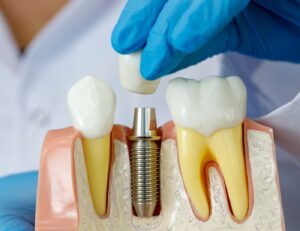The Dental Implant Healing Stages: Your Guide to Recovery
Dental implants are a remarkable solution for those with missing teeth, offering both aesthetics and functionality. While they provide a long-lasting alternative to traditional options like dentures or bridges, it’s crucial to understand the healing process and the stages involved. Healing after dental implant surgery takes time and patience, and this blog will guide you through the entire journey.
In this comprehensive guide, we will cover various aspects of dental implant healing, including the stages of recovery, post-operative care, and answers to frequently asked questions. So, let’s embark on this journey towards a healthier and happier smile.

Dental Implants Require Minor Surgery
Before diving into the healing stages, let’s understand the basics of dental implants. These implants involve a minor surgical procedure where a titanium post or screw is placed into your jawbone to serve as an anchor for your replacement teeth. The visible part that resembles a natural tooth is called a crown, often made of materials like zirconia or porcelain. Additionally, dental implants can support dentures made from acrylic or other materials.
The implantation process includes inserting the implant into the jawbone. In minimally invasive procedures, there’s no need for cuts or sutures. After placement, the bone naturally grows around the implant, anchoring it securely. This integration with the bone is called osseointegration and is a critical part of the dental implant process.
Dental implants can replace a single tooth, multiple teeth, or even an entire arch, making them a popular choice for various tooth replacement needs. They offer a natural-looking and functional solution while preserving the integrity of the jawbone over time.
The Dental Implant Healing Stages
Now that you have a grasp of what dental implants are, let’s delve into the four essential stages of healing:
1. The Surgical Stage: This is the initial step where the implant is placed into the jawbone. In minimally invasive procedures, no cutting or sutures are required.
2. The Osseointegration Healing Stage: Osseointegration is the process in which your jawbone grows around the implant, securely anchoring it in place. It’s a crucial step for the implant’s stability and functionality.
3. The Post-Implant Healing Stage: After the implant placement and the healing of gum tissue, you might need to wait for full integration with the jawbone. During this time, it’s recommended to follow a soft food diet and avoid applying excessive pressure to the implant site.
4. The Restoration Stage: Once the implant has completely integrated with the bone, your dentist can attach a dental crown, bridge, or denture to the implant. This stage involves taking impressions and creating the final restoration.
Each healing stage requires careful post-operative care to ensure proper healing and minimize the risk of complications. Your dentist’s instructions are crucial during these phases, so be sure to follow them diligently.
Pain After Dental Implant Surgery
After dental implant surgery, it’s normal to experience some mild swelling, bruising, or discomfort for a few days. Pain can typically be managed with over-the-counter or prescription pain medication. Your oral surgeon or dentist will provide specific guidance for managing pain or discomfort, which can vary from person to person.
The level of pain post-surgery depends on several factors, including the specific procedure, your personal pain tolerance, and overall health. While some people may experience minimal discomfort, others may have more pronounced pain. Generally, the pain should decrease over a few days as swelling and bruising subside.
Remember to adhere to your dentist’s instructions for post-operative care, including medication usage and avoiding strenuous activities that may disrupt the healing process. If you have concerns about pain or experience unusual symptoms, don’t hesitate to contact your dental care provider for additional guidance.
FAQs About the Dental Implant Healing Stages
- What should you avoid after dental implant surgery? After surgery, it’s essential to avoid strenuous activities, certain foods, and follow your doctor’s medication instructions. Maintaining good oral hygiene is also crucial for preventing infection.
- When can you eat normally after dental implants? Your diet may initially consist of soft foods for a few days to allow proper healing. You can gradually reintroduce solid foods as swelling and bruising subside.
- When can you drink alcohol after dental implants? It’s generally recommended to avoid alcohol for the first 24-48 hours after surgery to facilitate healing and minimize the risk of bleeding or infection.
- When can you smoke after dental implants? Smoking can interfere with the healing process and increase the risk of complications. It’s essential to discuss the potential risks with your dental care provider, especially if you’re a smoker.
- Is it safe to drive after dental implant surgery? Generally, it’s safe to drive after surgery, provided you’re no longer sedated and aren’t taking medications that affect your ability to drive. Always prioritize safety.
Understanding the dental implant healing stages and following post-operative care instructions will help ensure a successful recovery, bringing you one step closer to a healthier and happier smile.
